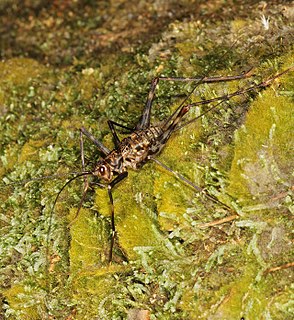
Conocephalus is a genus of bush-crickets, known as coneheads. It was described by Carl Peter Thunberg in 1815.

Gryllacrididae are a family of non-jumping insects in the suborder Ensifera occurring worldwide, known commonly as leaf-rolling crickets or raspy crickets. The family historically has been broadly defined to include what are presently several other families, such as Stenopelmatidae and Rhaphidophoridae, now considered separate. As presently defined, the family contains two subfamilies: Gryllacridinae and Hyperbaeninae. They are commonly wingless and nocturnal. In the daytime, most species rest in shelters made from folded leaves sewn with silk. Some species use silk to burrow in sand, earth or wood. Raspy crickets evolved the ability to produce silk independently from other insects, but their silk has many convergent features to silkworm silk, being made of long, repetitive proteins with an extended beta-sheet structure.

Phalangopsinae, occasionally known as spider crickets, are a subfamily of crickets in the family Phalangopsidae. Members of Phalangopsinae are found worldwide in tropical and subtropical regions. Most species in the subfamily are nocturnal and can be found in rocky areas, near fallen wood, and the understory of forests. Some species are gregarious, gathering in large numbers.

Hexacentrus is the type genus of bush-crickets in the subfamily Hexacentrinae. Most species of this genus occur in Southeast Asia and in Africa.

Gryllacridinae is an Orthopteran subfamily in the family Gryllacrididae.

Meconematinae is a subfamily of the bush crickets, with a worldwide distribution.

Mecopodinae are a subfamily of bush crickets found in western South America, sub-Saharan Africa, and Asia. In Asia, the distribution includes India, Indochina, Japan, the Philippines, and Malesia to Papua New Guinea and Australasia, including many Pacific islands.

Conocephalinae, meaning "conical head", is an Orthopteran subfamily in the family Tettigoniidae.

Agraeciini is a large tribe of bush crickets or katydids in the conehead subfamily, Conocephalinae.

The Listroscelidinae are a subfamily of the Tettigoniidae found in the Americas, Madagascar, and Australia.
Xiphidiopsis is a genus of bush crickets in the subfamily Meconematinae. Species have been recorded from: India, China, Japan, Indochina, Malesia, and islands in the Indian Ocean and Pacific.
Tympanophyllum is a genus of Southeast Asian bush-crickets in the tribe Phyllomimini within the subfamily Pseudophyllinae. Species have been recorded from India, through Indo-China and Malesia to New Guinea. The genus was named in 1902.
Teratura is a genus of Asian bush crickets belonging to the tribe Meconematini. Species have been recorded from India, Indo-China, China and Peninsular Malaysia.

Anelytra is an Asian genus of bush crickets in the tribe Agraeciini, belonging to the 'conehead' subfamily Conocephalinae.
Liara is an Asian genus of bush crickets in the tribe Agraeciini, belonging to the 'conehead' subfamily Conocephalinae.

Pseudorhynchus is an Asian genus of bush crickets in the tribe Copiphorini, belonging to the 'conehead' subfamily Conocephalinae.

The Phalangopsidae are a recently reconstituted family of crickets, based on the type genus PhalangopsisServille, 1831 from South America. Priority for family-group names based on this genus dates from Blanchard's "Phalangopsites".

Gryllini is a tribe of crickets and typical of the family Gryllidae. Species are terrestrial, carnivorous or omnivorous and can be found in all continenents except Antarctica.

Diaphanogryllacris is a genus of Orthopterans, sometimes known as 'leaf-folding crickets' in the subfamily Hyperbaeninae and tribe Capnogryllacridini. The recorded distribution is: the Indian subcontinent, China, Indochina, western Malesia up to Sulawesi.
Rhinoteratura is a genus of Asian bush crickets belonging to the tribe Meconematini in the new subtribe Meconematina. The genus was erected by AV Gorochov in 1993 as a subgenus of Leptoteratura (Rhinoteratura); he uprated it to genus level in 2022. Species are recorded from Japan, China, Vietnam, and west Malesia.
















